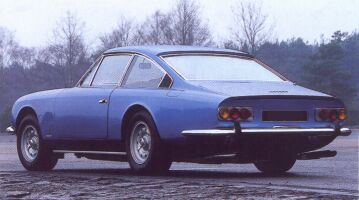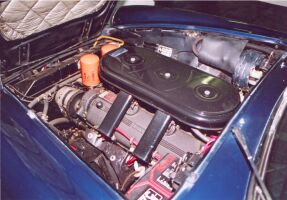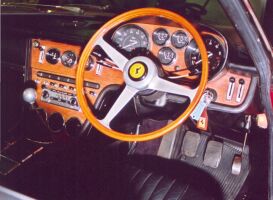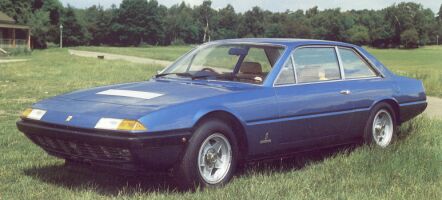 This
page covers the following models :
This
page covers the following models :
365 California
365 GTS
365 GTC
365 GT 2+2
the 365 GTB/4 Daytona and 365 GTS/4 Spider are on a separate page
365 GTC/4
365 GT4 2+2
the 365 GT4 BB Berlinetta Boxer is under Berlinetta Boxers
The replacement for the 500
Superfast, the 365 California, introduced at the Geneva Motorshow in
1966, used that cars chassis, suspension and gearbox. A further development
of the companys existing V12 resulted in a 4390cc unit with 320bhp which
gave the California a top speed of around 240km/h.
The body, by Pininfarina, was a two seat
convertible. The front end was similar to the Superfast, but the rest was
new. As well as being the fastest production cabriolet in the world at
that time it was fitted with power assisted steering and air conditioning
as standard.
Only 14 examples were built before production
stopped in 1967.
Technical Details
| Engine | 4390cc (81x71mm) 60deg V12 sohc (per bank) 320bhp @ 6,600rpm |
| Suspension | front : independent with double wishbones
rear : live axle with coil springs wheelbase : 2650mm track (front/rear) : 1430mm/1460mm |
| Brakes | discs all round |
| Transmission | 5 speed manual |
| Empty weight | 1320kg |
This was simply a 330GTS (itself a re-engined
275GTS) with the 4390cc sohc engine. About the only other difference was
the deletion of the cooling vents behind the front wheels and the fitment
of vents in the bonnet.
The total production run was 20 cars.
Technical Details
| Engine | 4390cc (81x71mm) 60deg V12 sohc (per bank) 320bhp @ 6,600rpm |
| Suspension | front : independent with double wishbones and coil springs
rear : independent with double wishbones and coil springs wheelbase : 2400mm track (front/rear) : 1401mm/1417mm |
| Brakes | discs all round with servo assistance |
| Transmission | 5 speed manual |
 This
was introduced very late in 1968 and was a 330 GTC fitted with the 4390cc
sohc engine. As with the GTS models, the air vents in the front wings were
deleted, and replaced by matt black vents in the rear corners of the bonnet,
and a minor internal facelift improved the cockpit. It was built from 1969
until 1970 with about 150 cars being produced.
This
was introduced very late in 1968 and was a 330 GTC fitted with the 4390cc
sohc engine. As with the GTS models, the air vents in the front wings were
deleted, and replaced by matt black vents in the rear corners of the bonnet,
and a minor internal facelift improved the cockpit. It was built from 1969
until 1970 with about 150 cars being produced.
Technical Details as for the 365 GTS
The design was, as usual, by Pininfarina
and followed approximately the established Ferrari nose treatment coupled
with a long overhang at the rear to provide a useful boot. The rear passengers
had sufficient legroom when the front seats were not to far back, but headroom was limited. This
car, introduced in 1967, was Ferrari's second production four seater. Designed
to replace the 250GTE/330GT, its function was to provide comfort as well
as the performance expected of a Ferrari. To accomplish this it was fitted
with electric windows, power assisted steering, leather interior, full
carpeting, assisted brakes and optional air conditioning. The other requirement
was met by the installation of a 4390cc V12 with 320bhp, independent suspension
and disc brakes all round and a five speed manual gearbox.
This
car, introduced in 1967, was Ferrari's second production four seater. Designed
to replace the 250GTE/330GT, its function was to provide comfort as well
as the performance expected of a Ferrari. To accomplish this it was fitted
with electric windows, power assisted steering, leather interior, full
carpeting, assisted brakes and optional air conditioning. The other requirement
was met by the installation of a 4390cc V12 with 320bhp, independent suspension
and disc brakes all round and a five speed manual gearbox.
Production continued until 1971, and during this time it accounted for a significant amount of Ferraris total production. The final figure produced was 800.
Technical Details
| Engine | 4390cc (81x71mm) 60deg V12 sohc (per bank) 310bhp @ 6,600rpm |
| Suspension | front : independent with double wishbones and coil springs
rear : independent with double wishbones and coil springs wheelbase : 2650mm track (front/rear) : 1438mm/1468mm |
| Brakes | discs all round |
| Transmission | 5 speed manual |
| Empty weight | 1480kg |
365 GTB/4 Daytona & 365 GTS/4 Daytona Spider
There is a separate page on this model. Click here.
Replacing the 365 GT 2+2
in production in 1971 it also replaced the 330GTC and 365GTC
in the market. Mechanically it used primarily a Daytona chassis together
with its independent suspension but with a front mounted gearbox and a
revised 4390cc V12 with the carburettors (six sidedraught Webers) mounted
outside the 'V' on the sies of the cuylinder heads. Wet sump lubrication
was used and a power output of 340bhp was achieved. The ventilated discs
from the Daytona were also used, whilst other Ferraris contributed the
air conditioning unit, power steering and self-levelling rear suspension.
The design, again by Pininfarina, was a
two door coupe with 2+2 seating. Pop-up headlights were again used, as
were the five-spoke alloy wheels. A total of 500 examples were produced
before production ceased in 1972, the year after it began.
Technical Details
| Engine | 4390cc (81x71mm) 60deg V12 dohc (per bank) 310bhp @ 6,600rpm |
| Suspension | front : independent with double wishbones and coil springs
rear : independent with double wishbones and coil springs wheelbase : 2500mm track (front/rear) : 1470mm/1470mm |
| Brakes | discs all round |
| Transmission | 5 speed manual |
| Steering | rack and pinion |
| Empty weight | 1,450kg |
Production continued until 1976 when it
was replaced by a derivative, the 400. About 470 examples were built. Replacing
the 365 GT 2+2 as the four seater Ferrari in the marketplace, and the 365
GTC/4 on the production line, the 365 GT4 2+2 was released at the Paris
Motorshow in 1972. It used a stretched 365 GTC/4 chassis with the basically
the same suspension, brakes, engine and transmission but clothed in an
all new body. This improved the space for the rear passengers and luggage
significantly whilst still having only two doors. The external styling,
by Pininfarina, had virtually no links with earlier Ferraris (apart from
the five-spoke wheels) and introduced a new, angular look.
Replacing
the 365 GT 2+2 as the four seater Ferrari in the marketplace, and the 365
GTC/4 on the production line, the 365 GT4 2+2 was released at the Paris
Motorshow in 1972. It used a stretched 365 GTC/4 chassis with the basically
the same suspension, brakes, engine and transmission but clothed in an
all new body. This improved the space for the rear passengers and luggage
significantly whilst still having only two doors. The external styling,
by Pininfarina, had virtually no links with earlier Ferraris (apart from
the five-spoke wheels) and introduced a new, angular look.
Technical Details
| Engine | 4390cc (81x71mm) 60deg V12 dohc (per bank) 310bhp @ 7,700rpm |
| Suspension | front : independent with transverse parallelograms and coil springs
rear : independent with transverse parallelograms and coil springs wheelbase : 2700mm track (front/rear) : 1470mm/1500mm |
| Brakes | ventilated discs all round |
| Transmission | 5 speed manual |
| Empty weight | 1,500kg |
See our picture gallery index for images from museums, motorshows and events.
There are also wallpapers/desktop backgrounds available to download.
Use the buttons at the top to navigate
further, or
Copyright © 2000 to 2011 CarsfromItaly